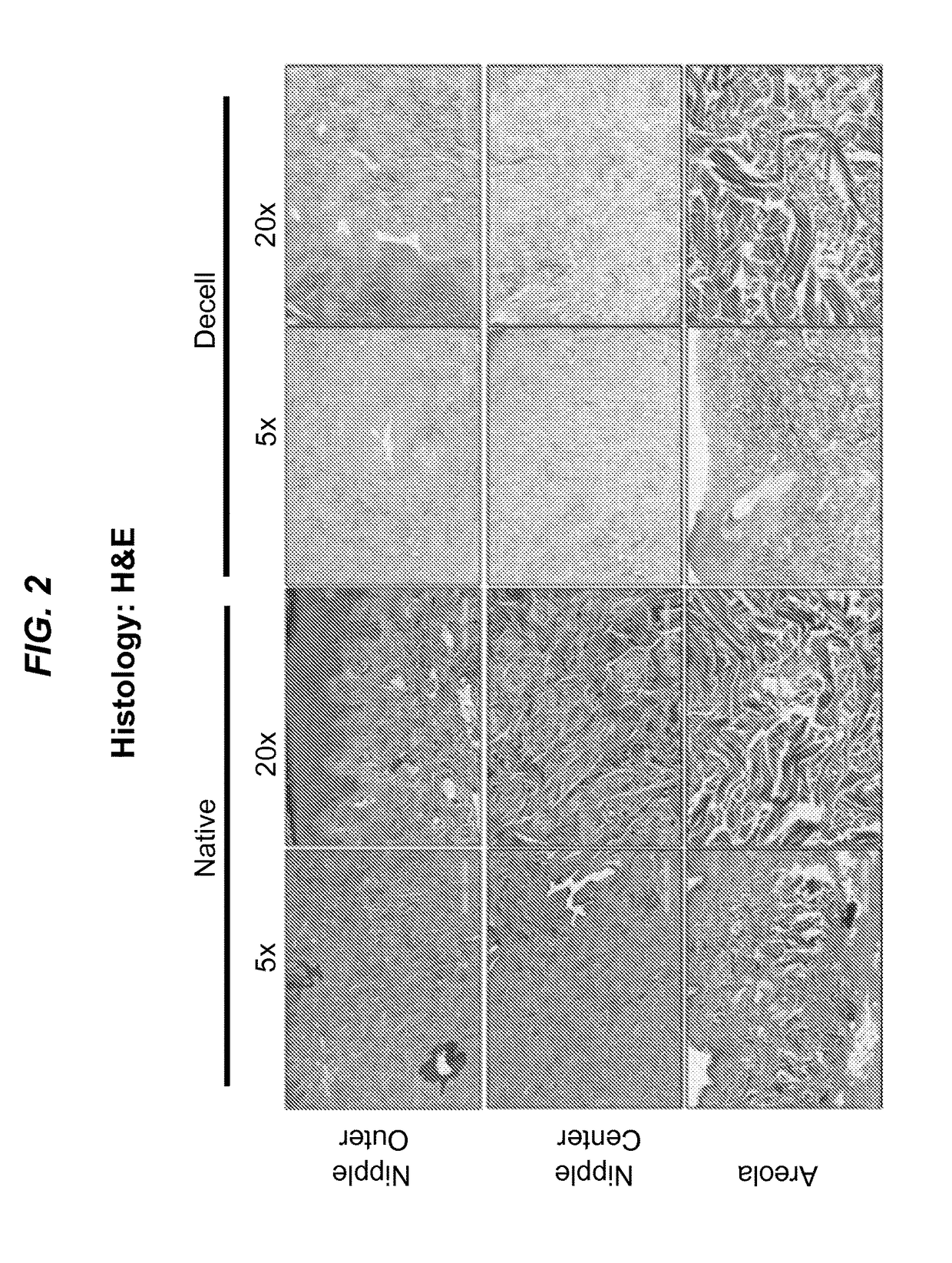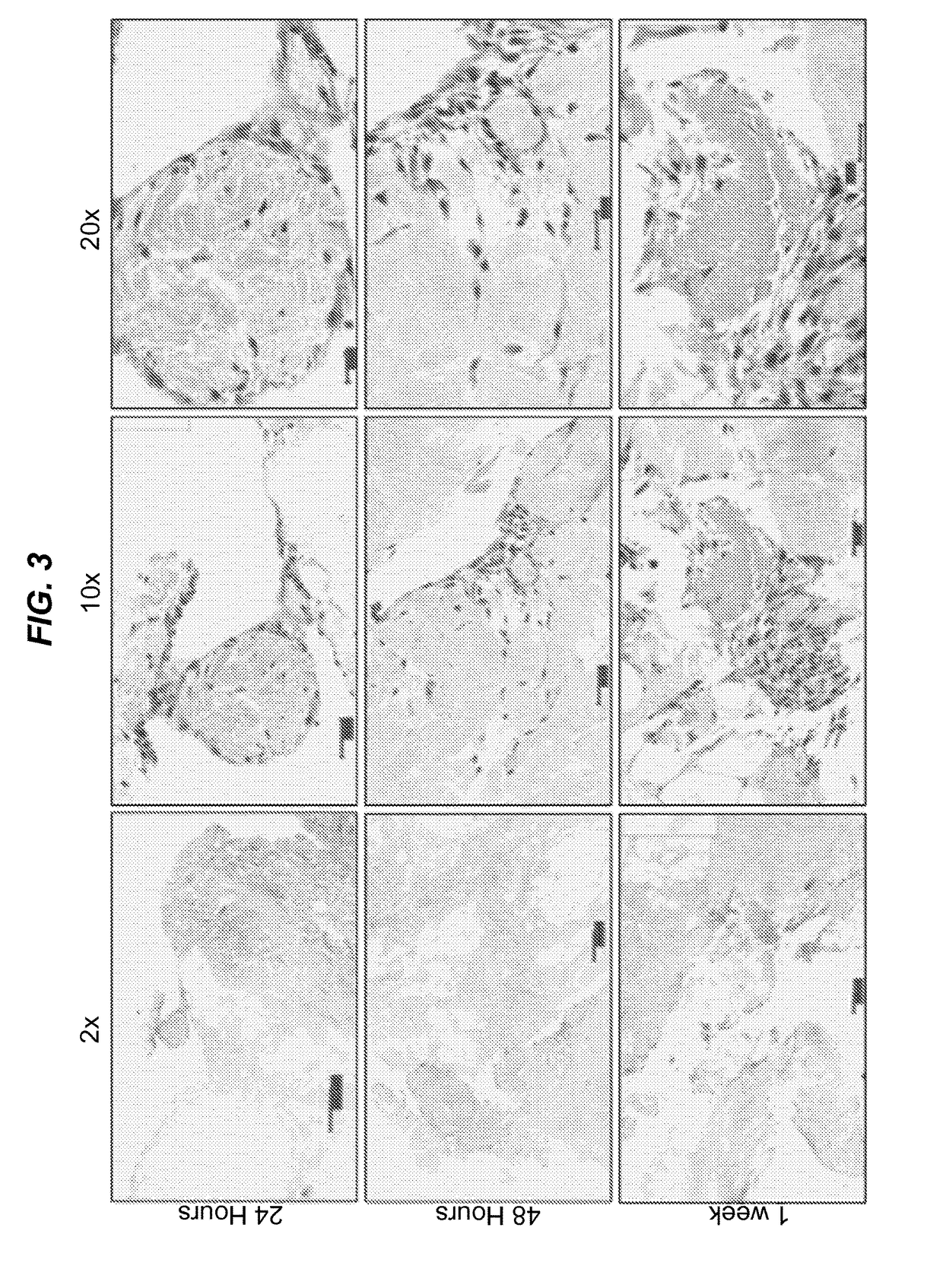Surgical grafts for replacing the nipple and areola or damaged epidermis
a technology of nipple and areola, which is applied in the field of surgical grafts for replacing the nipple and areola or damaged epidermis, can solve the problems of unsatisfactory surgical solutions to maintain nipple projection following nipple reconstruction, and the general surgical method has proved less than ideal, so as to achieve the effect of decellularizing the epidermis, decellularizing additional cells, and substantial decellularization
- Summary
- Abstract
- Description
- Claims
- Application Information
AI Technical Summary
Benefits of technology
Problems solved by technology
Method used
Image
Examples
example 1
[0072]This example sets forth materials and methods used in studies reported herein.
[0073]The process depicted in FIG. 1 used tissue samples collected by trained veterinary technicians at Tulane National Primate Research Center (TNPRC). The technicians collected Rhesus macaque (Macaca mulatta) nipple and areola tissue from animals undergoing routine euthanasia due to chronic diarrhea or self-mutilation, as well as from control animals from various experiments. All animal procedures conformed to the requirements of the Animal Welfare Act and all animal protocols were approved by the Institutional Animal Care and Use Committee (IACUC) of the TNPRC before implementation of experimental protocols. Rhesus macaque tissue samples were decellularized through a modified protocol previously described by Bonvillain et. al., Tissue Eng: Part A, 18(23-24): 2437-52 (2012) (“Bonvillain 2012”), and Scarritt et. al., Tissue Eng: Part A, 20(9-10):1426-43 (2014) (“Scarritt 2014”). In ...
example 2
[0082]This Example sets forth the results of studies conducted in the course of the work reported herein.
Detergent-Based Decellularization Effectively Removes Cells from NAC Tissue
[0083]To determine the efficiency of decellularization to remove DNA from rhesus macaque NAC, gDNA was isolated from native and decellularized NAC tissue (FIG. 7A). There was a significant reduction in DNA content with native NAC containing 2,022.71 (SEM: 751.90) ng DNA per mg lyophilized tissue and decellularized NAC containing 56.51 (SEM: 8.45) ng of DNA per mg of lyophilized tissue (p<0.05). Gel electrophoresis of 1.5 ug of gDNA from native NAC appeared as a heavy, high molecular weight band, whereas DNA from decellularized NAC consisted of small fragments of degraded DNA that did not create a banding pattern (FIG. 7 B).
[0084]To investigate the potential application of decellularization for the generation of tissue-engineering scaffolds for breast reconstruction, NAC tissue was exposed to a series of de...
example 3
[0087]This Example discusses the results set forth in the preceding Example.
[0088]This study demonstrated that a dermal / semi-glandular structure such as the nipple and areola complex can be sufficiently decellularized. Decellularization efficiency was determined based on three key criteria, as outlined by Crapo et al., Biomaterials, 32(12):3233-43 (2011): no visible signs of cells or cell debris, reduction of DNA to less than 50 ng per mg tissue, and degradation of any remaining DNA to less than 200 bp. These criteria are based on the principle that cellular debris, high concentrations of DNA, or the presence of long DNA fragments in a decellularized tissue are potentially immunogenic and, therefore, detrimental to successful incorporation post-transplantation. The concentration of genomic DNA isolated from decellularized NAC was about 56 ng per mg of lyophilized tissue and no visible banding of DNA fragments were found when DNA from decellularized NAC was electrophoresed. The avera...
PUM
| Property | Measurement | Unit |
|---|---|---|
| time | aaaaa | aaaaa |
| temperature | aaaaa | aaaaa |
| pressure | aaaaa | aaaaa |
Abstract
Description
Claims
Application Information
 Login to View More
Login to View More - R&D
- Intellectual Property
- Life Sciences
- Materials
- Tech Scout
- Unparalleled Data Quality
- Higher Quality Content
- 60% Fewer Hallucinations
Browse by: Latest US Patents, China's latest patents, Technical Efficacy Thesaurus, Application Domain, Technology Topic, Popular Technical Reports.
© 2025 PatSnap. All rights reserved.Legal|Privacy policy|Modern Slavery Act Transparency Statement|Sitemap|About US| Contact US: help@patsnap.com



